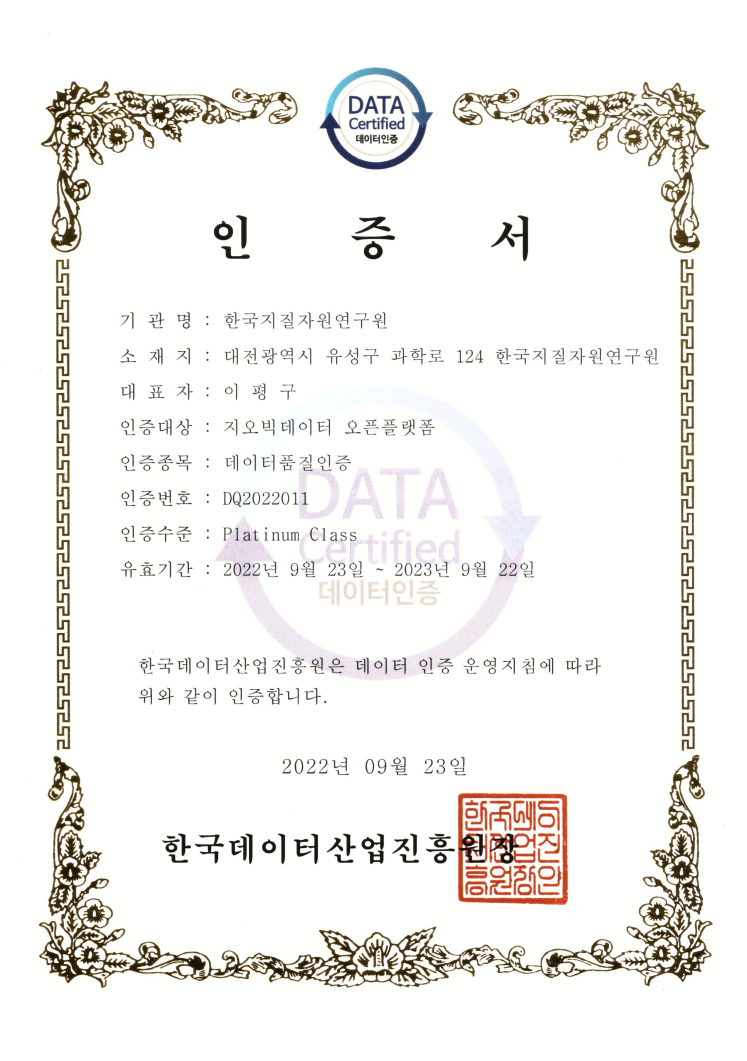경주 오도리 부채꼴 주상절리의 독특한 용암 지형
Data Quality Certification (DQC-V)

| Data type | KIGAM 보고서 |
|---|---|
| Title | 지열 자원 조사 연구 [1998] |
| Author | 진명식 |
| Language | KOR |
| Call Number | KR-98-C-07-1998-R |
| Publication Information | 韓國資源硏究所, 1998 |
| Abstract | 이번 연구에서는 광주 1:25만 지형도를 기준으로 광주도폭의 반에 해당하는 지역으로 중점적으로 연구하였다. 특히 지열은 화강암과 밀접한 관계가 있기 때문에 조사지역내의 화강암류에 대해 열생산 요소인 방사능 동위원소 (U, Th, K) 및 열전달 요소인 열전도도를 측정하였다. 또한 기조사자료를 수집하여 조사지역에 대한 종합적인 지열특성을 파악하고자 하였다. 암석시료를 채취하여 실내에서 열전도도 측정은 QTM(Quick Thermal conductivity Meter)를 이용하였으며, 방사성 동위원소 분석은 NAA에 의한 방법을 사용하였다. 조사지역내의 화강암류는 쥬라기 화강암과 엽리상 화강암류가 주로 분포하고 있어 이에 대한 지열 특성을 알아보았다. 열전도도의 차이를 보면 쥬라기 화강암은 2.76W/mK, 엽리상 화강암은 2.78W/mK로써 화강암의 암상별 차이는 거의 없는 것으로 나타났다. 그러나 우리 나라 화강암류 전체의 열전도도 값이 평균 2.53W/mK 보다 높은 편으로 나타났다. 이것으로 볼 때 우리 나라 전역이 일정한 지열류량을 보인다고 가정했을 때 조사지역은 상대적으로 낮은 지온경사를 갖을 것으로 보았다. 역시 조사지역의 심부 시추공의 온도검층결과를 볼 때 23.47℃/km으로 우리 나라 평균 지온경사 25.59 ℃/km 보다 낮음을 알 수 있었다. 열전도도와 지온경사를 이용한 지열류량 값을 구해보면 조사지역은 46-87mW/㎡ 범위로 나타났다. 방사성 동위원소 분석 결과 조사지역의 쥬라기 화강암과 엽리상 화강암의 구분이 뚜렷하게 나타났다. 쥬라기 등립질화강암은 U 4.58-4.80(ppm), Th 15.73-19.13(ppm), K 3.31-4.12(wt%)의 함량을 보였으며, 엽리상 화강암은 U 1.83(ppm), Th 14.71(ppm), K 5.05(wt%)으로 엽리상 화강암이 K를 많이 함유하고 있으나 U, Th는 쥬라기 등립질 화강암보다 낮은 편이다. 열생산량을 비교하면 쥬라기 등립질 화강암이 2.58-2.945μW/㎥, 엽리상 화강암이 1.96μW/㎥으로 쥬라기 등립질 화강암류가 높은 값을 보였다. 이상과 같이 조사지역 화강암류의 지열적 특성을 연구한 결과 화강암의 암상별 차이는 방사성 동위원소 분석에는 확실하게 차이가 났으나 열전도도 차이는 거의 없는 것으로 나타났다. 앞으로 생성시대별 화강암류의 지열적 특성을 비교하여 우리나라 화강암 분포에 따른 지열적 특성을 파악할 계획이다 This report is resulted from the study focused on the regional exploration for geothermal resources in the area of the northwestern half of the Gwangju sheet of 1:250,000, in 1998. Generally geothermal resources, i.e. mostly hot springs, in Korean Peninsula are closely related to the distribution of granitoids, because of radiogenic heat accumulated in the granitic rocks. Accordingly radiogenic element (U, Th, and K) abundance and thermal conductivity of the granitic rocks are determined by NAA(Neutron Activation Analysis) method and QTM (Quick Thermal Conductivity Meter), respectively. The uranium, thorium and potasium content, in the Namwon granites (non-foliated biotite granites) of the Jurassic ranges 2.14-6.23 ppm (mean;4.58ppm), 6.62-28.9 ppm (mean;15.73ppm), 2,88-3.91%(mean;3.31%), and those in foliated biotite granites of the Jurassic ranges 0.80-7.82 ppm (mean;1.83ppm), 8-50.8 ppm (mean;14.71ppm) and 2.05-7.20% (mean;5.05ppm), respectively. And uranium, thorium and potasium content in the Jurassic granites of the Jeonju-Buan area range 1.53-11.20 ppm (mean;4.8ppm), 10.8-39.5 ppm(mean;19.13ppm), and 3.43-5.05%(mean;4.12%), respectively. Consequently, the heat production rate is the highest in the granites of the Jeonju-Buan area (2.94μW/㎥), and lowest in the foliated granite of the Jurassic (1.96μW/㎥). However, regardless of the rock type, the geothermal conductivity of the granites shows a range of 2.76-2.78 W/mK with little difference. These values are a little higher than average of those in Korea. In the light of the heat production rate, the Jeonju-Buan granites show some possibilities to prospect geothermal resources, but the study area appears to display comparatively low geothermal gradient in comparison with other areas, if there would keep average heat flow |
| Page | 72 p. |
| Keyword | 지열, 지온, 익산, 전주, 김제, 정읍, 고창, 영광 |
| Source |
Comments